Updated UNOOSA and ESA space debris infographics and podcasts
What is this series about?
Space debris is an issue of global concern that threatens our continued use of near-Earth space for the benefit of humankind. To raise awareness about this growing problem, ESA and the United Nations Office for Outer Space Affairs (UNOOSA) have created a series of nine infographics and podcasts that tell the story of space debris, explain the risks and illustrate the solutions available to ensure future space exploration remains sustainable. Scroll down to see the infographics and listen to the podcasts.
A limited natural resource
Space may seem vast, but the orbits around Earth in which satellites reside are a limited natural resource. Accidental collisions, explosions and even the intentional destruction of satellites have created millions of debris fragments, which, orbiting at high speed, can damage or destroy any functioning spacecraft that crosses their path.
As satellite technology becomes ever more relied upon, it gets increasingly important to protect these unique orbital regions that are essential for humanity to, for example, gather data for weather forecasting and to better understand extreme weather and our changing climate, as well as for internet access, communication and location services.
A concern to all nations
Unfortunately, the amount of space debris in orbit is increasing at an exponential rate. As a growing number of countries and actors begin space activities - a hugely positive development in general - and as satellite operations become more complex and the number of objects being launched, including in large constellations, rapidly increases, so too do the challenges posed to our space environment.
In 2019, ESA's Space Safety programme was adopted as a key pillar in the Agency's activities. The programme, an expansion of the former Space Situational Awareness programme, includes ESA's Space Debris and Clean Space Offices, which are working to better understand the debris environment, prevent the creation of more debris, reduce the amount in orbit and lessen the impact of space activities on Earth.
In 2018, the United Nations General Assembly expressed its worry about the fragility of the space environment and the impact of space debris, which is an issue of concern to all nations. In 2019, the United Nations Committee on the Peaceful Uses of Outer Space (COPUOS), of which UNOOSA is Secretariat, adopted the Guidelines for the Long-Term Sustainability of Outer Space Activities (LTS Guidelines), which provide guidance to help ensure the safe and sustainable use of space. The LTS Guidelines were subsequently welcomed with appreciation by the United Nations General Assembly, and a new working group will continue multilateral discussions on the topic.
Raising awareness
This series of infographics jointly produced by UNOOSA and ESA include attractive, easy-to-understand illustrations, facts and figures so that everyone, with or without any previous knowledge of spaceflight, can understand space debris and the challenge it poses. They cover topics such as how debris is created, how to avoid collisions, the risk to humans in space from debris and on Earth from re-entries, as well as technologies for safe debris mitigation and removal.
Each of the nine infographics is accompanied by a podcast with audio commentary from UNOOSA and ESA experts, who help navigate and understand the material.
The infographics and podcasts were originally released in 2021 and updated with data accurate as of June 2023.
"A new era of space has begun, in which large constellations of thousands of satellites are being launched to the skies," said former ESA Director General Jan Wörner. "What this 'New Space' makes possible - global internet access, telecommunications - it also threatens, as a rapid increase in space traffic may dramatically increase the chance of collisions. Innovative technologies, responsible behaviour and importantly international cooperation are fundamental to ensuring our future in space is sustainable."
Former UNOOSA Director Simonetta Di Pippo said: " Space debris poses a clear risk for the long-term sustainability of outer space activities. The space economy calls for a safe, secure and sustainable space environment. UNOOSA welcomes working with ESA to disseminate clear, accessible public information on space debris that will increase awareness of the challenges they pose and contribute to strengthening international cooperation on mitigation measures."
Infographic 1: satellites versus debris
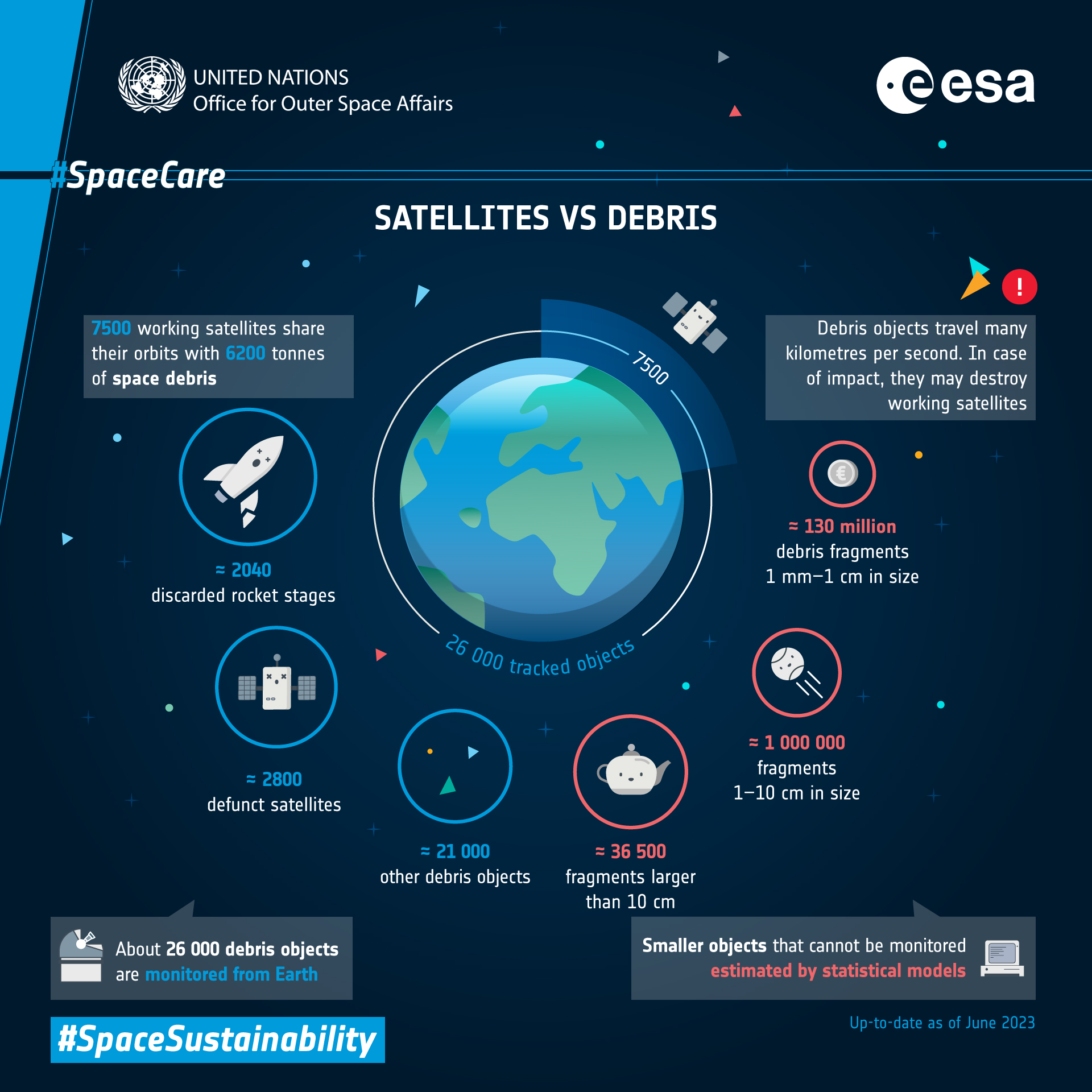
Space debris is a topic of global concern. While space has brought huge benefits to individuals and societies across the globe, the rapid increase of launched objects and increased traffic in our space highways means we are creating ever-more debris and threatening the very technologies we have come to rely on. Acknowledging the significance of this problem, UNOOSA and ESA have come together to raise awareness with a series of nine infographics that tell the space debris story so far and illustrate some of the solutions available for us to achieve a sustainable use of space.
Satellites in orbit share near-Earth space with millions of fast-moving and dangerous debris objects. From tiny fragments millimetres in size to entire satellites no longer working, no longer controlled, roaming the space highways, each debris piece travels many kilometres per second. Any impact with one of these objects threatens to at least impair the functioning of a working spacecraft, or at worst destroy it altogether, creating ever more debris. In this infographic from ESA and the UN, find out about the scale of the debris problem: how much of it is up there, what scales are we talking about, and what are our satellites are up against? Find out more in Episode one of the corresponding ESA & UN podcast below, "Satellites vs. debris".
Listen to the podcast here: https://soundcloud.com/esa/satellites-vs-debris
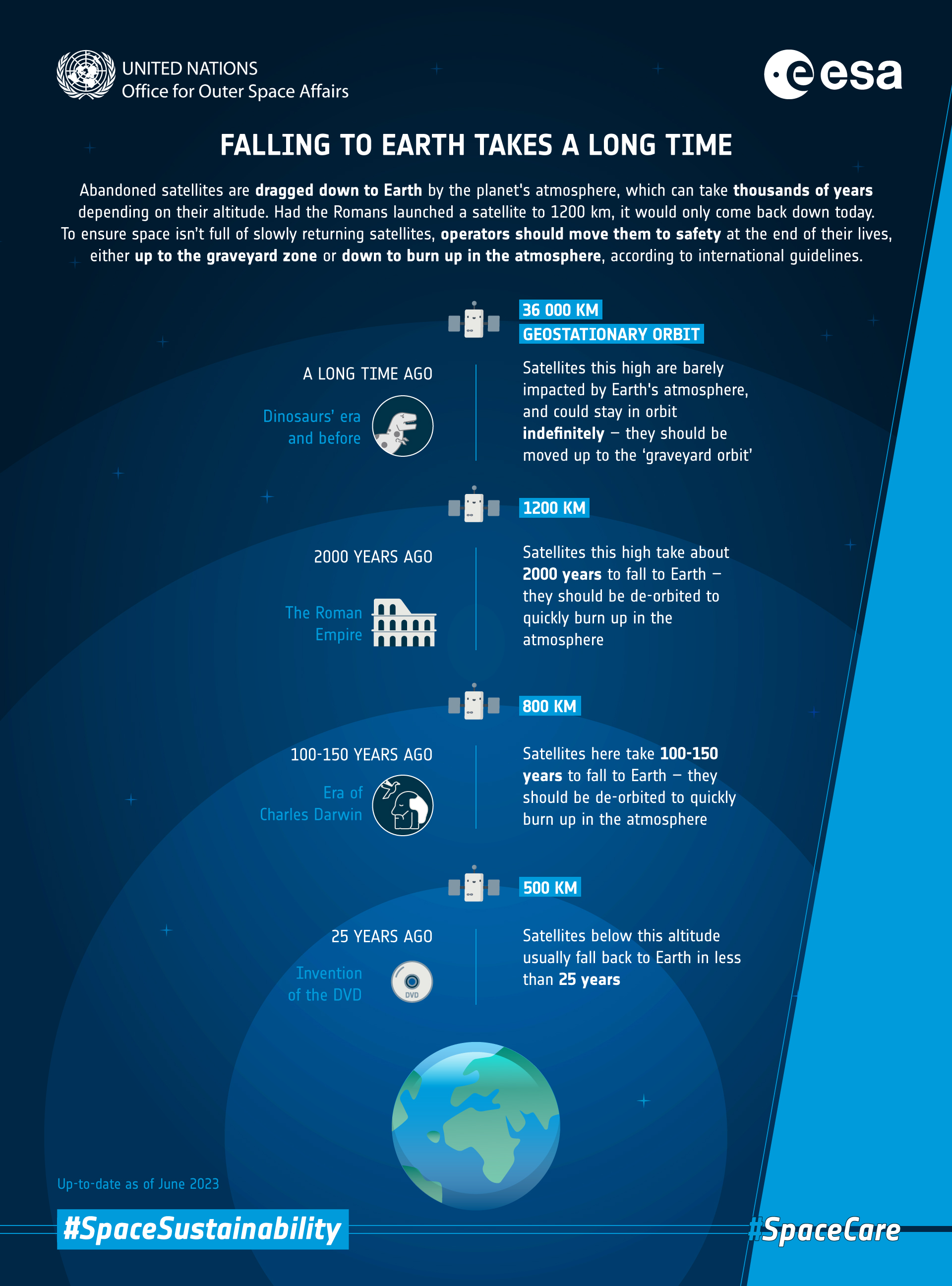
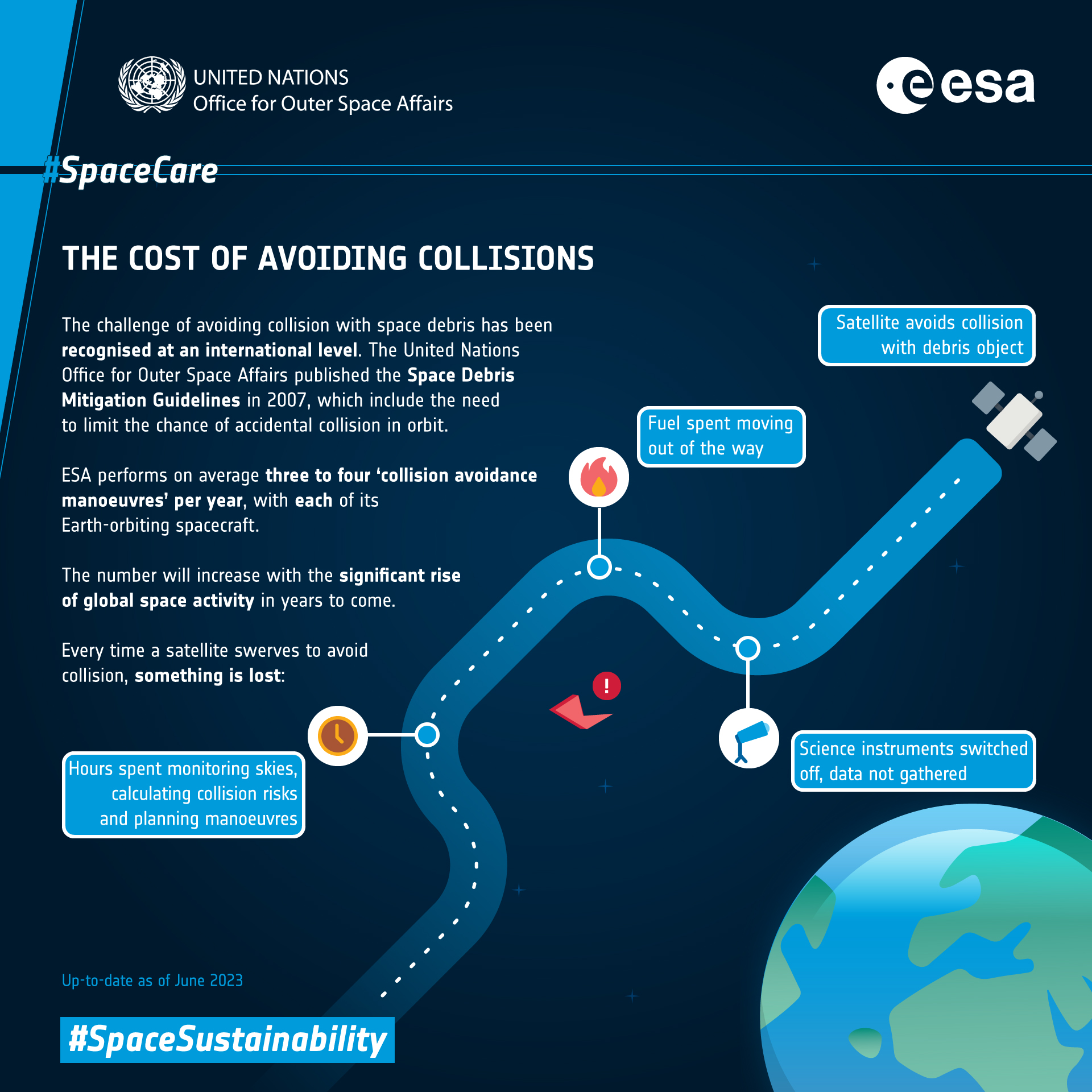
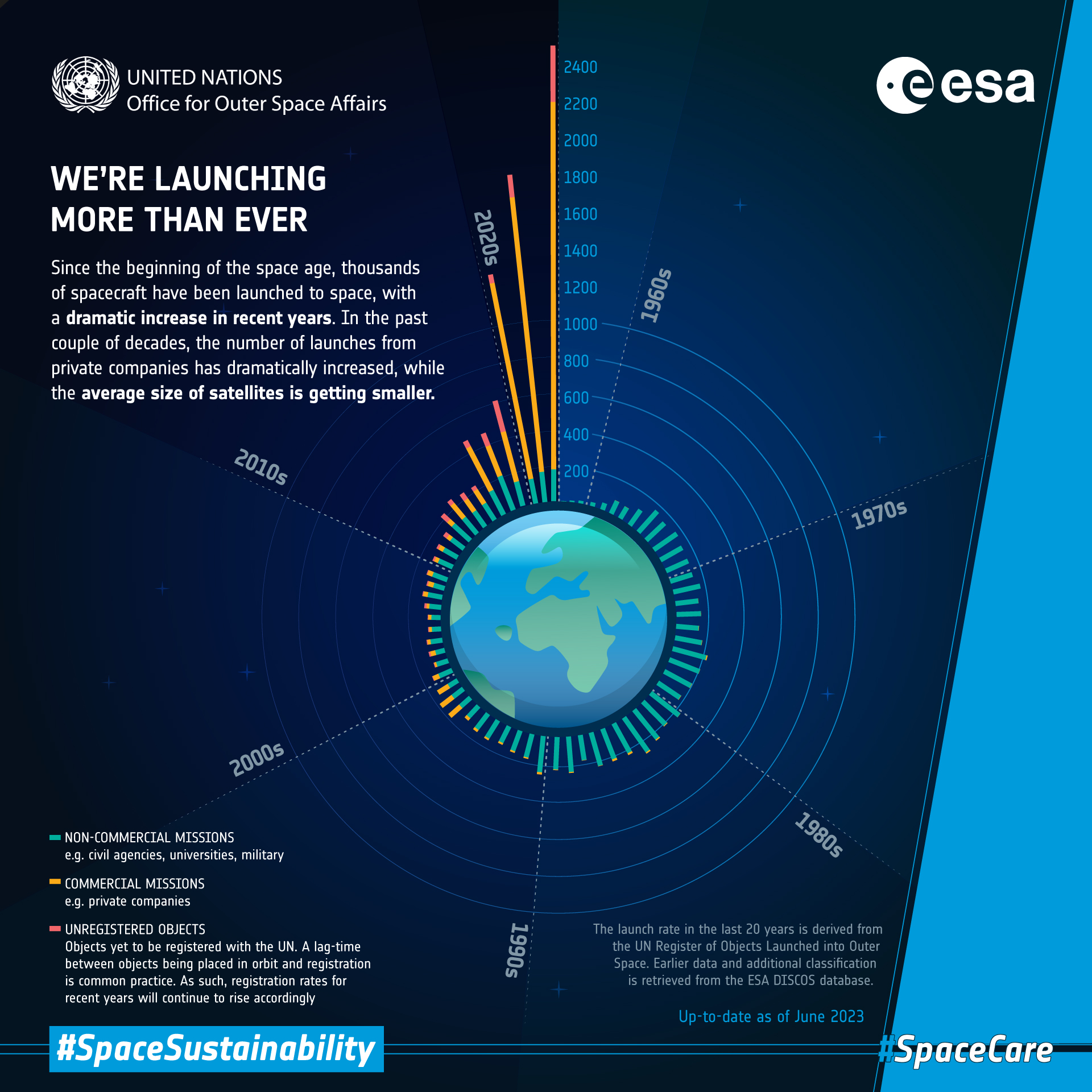
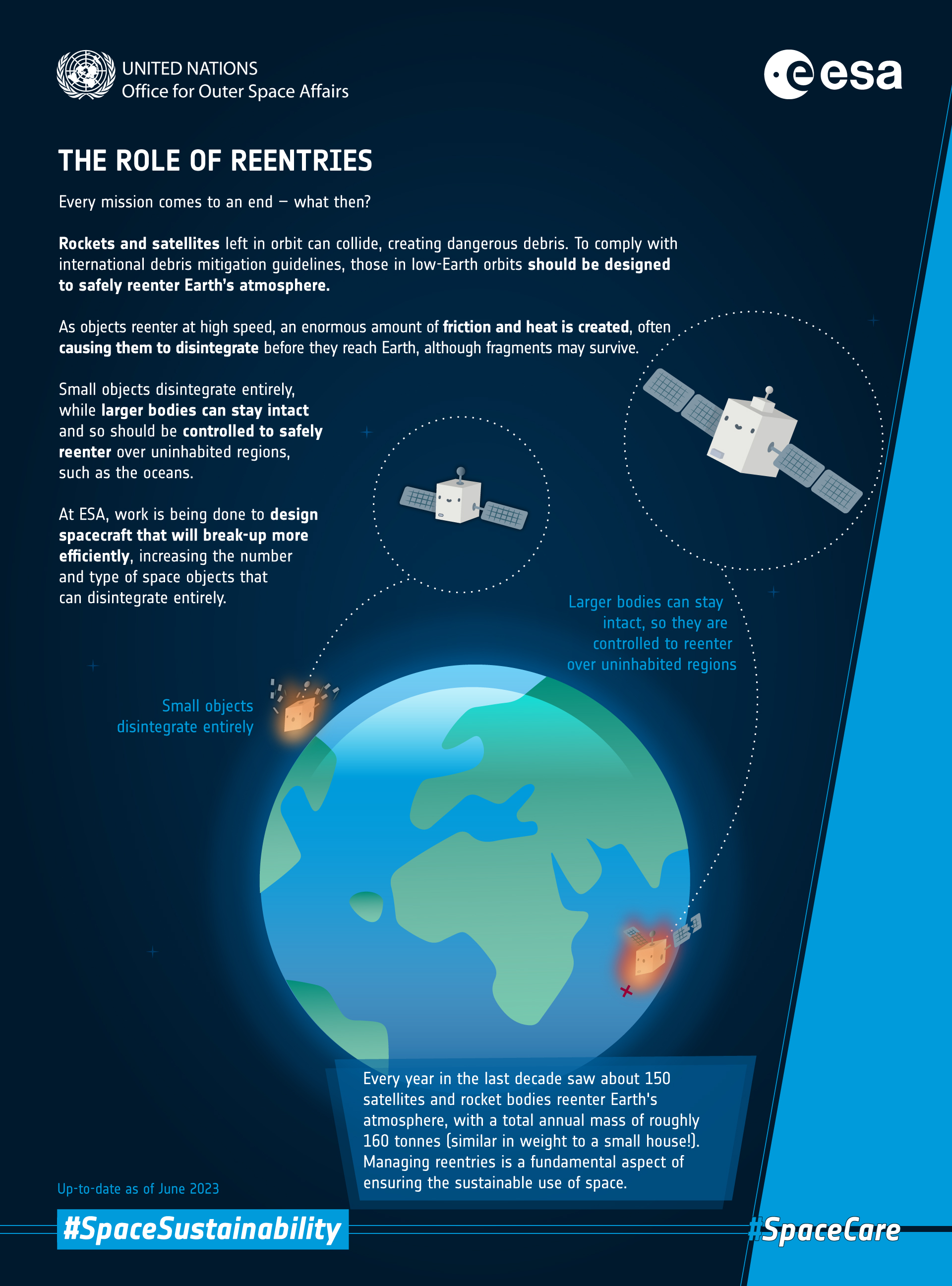
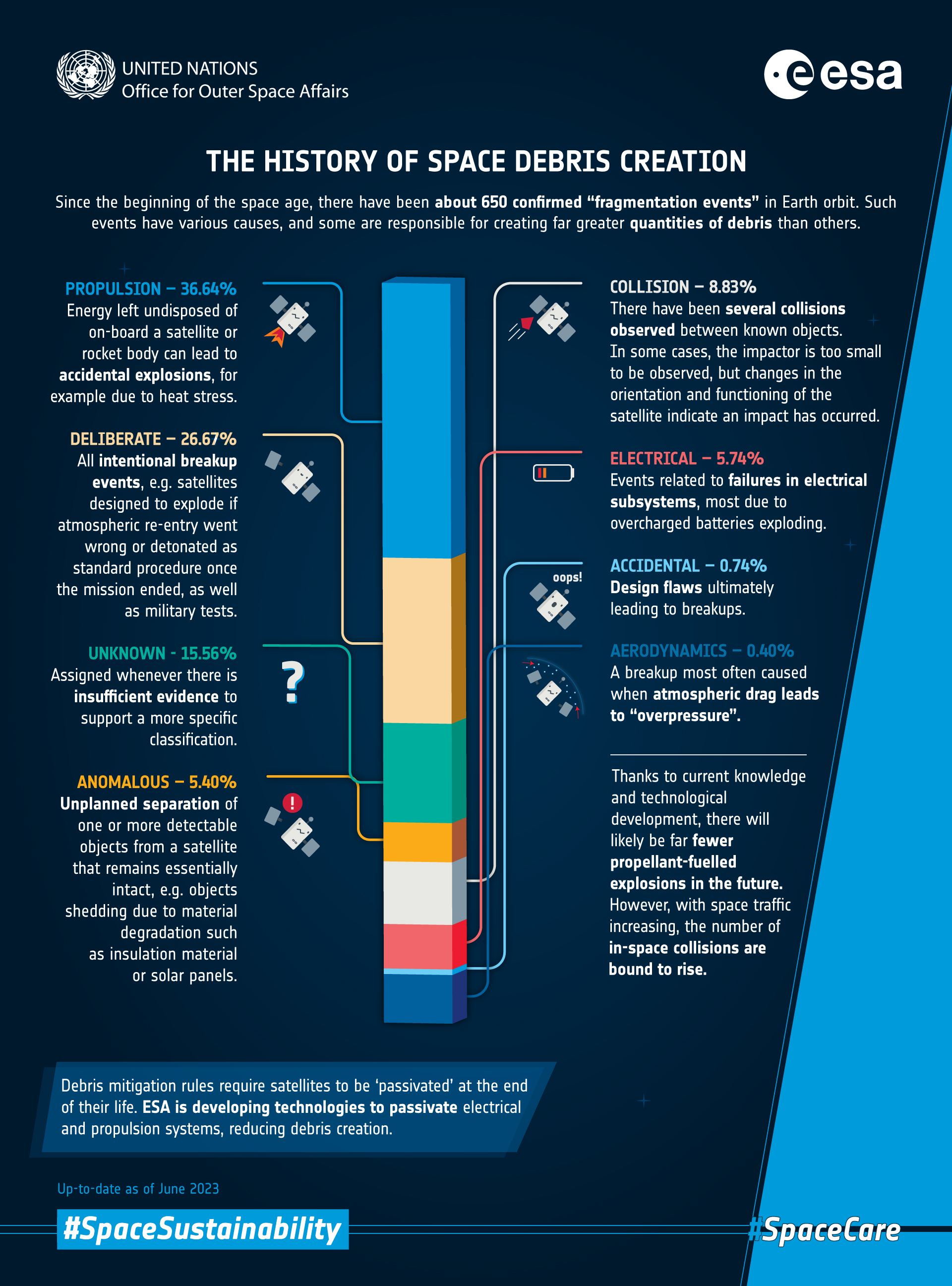
The millions of fragments of debris in orbit today are the direct result of 'fragmentation events' in the past. Of the 550 events known to date, those caused by propulsion have created the greatest amount of space debris. Energy left undisposed of on-board a satellite or rocket body can lead to explosions. For this reason, the international space debris mitigation guidelines require that satellites are 'passivated' at the end of their mission - for example by emptying fuel tanks and disconnecting batteries. Because of these guidelines, and passivation technologies being developed by ESA and others, we expect a graph for the future to have far fewer propellant-fueled explosions. However, as traffic in space rapidly increases, the number of collisions is expected to rise. Find out how we know about the causes of debris-creating events, and how this can help us prevent them in the joint UNOOSA-ESA podcast below that narrates this infographic.
Listen to the podcast here: https://soundcloud.com/esa/where-todays-debris-came-from
Infographic 7: the impact of space debris
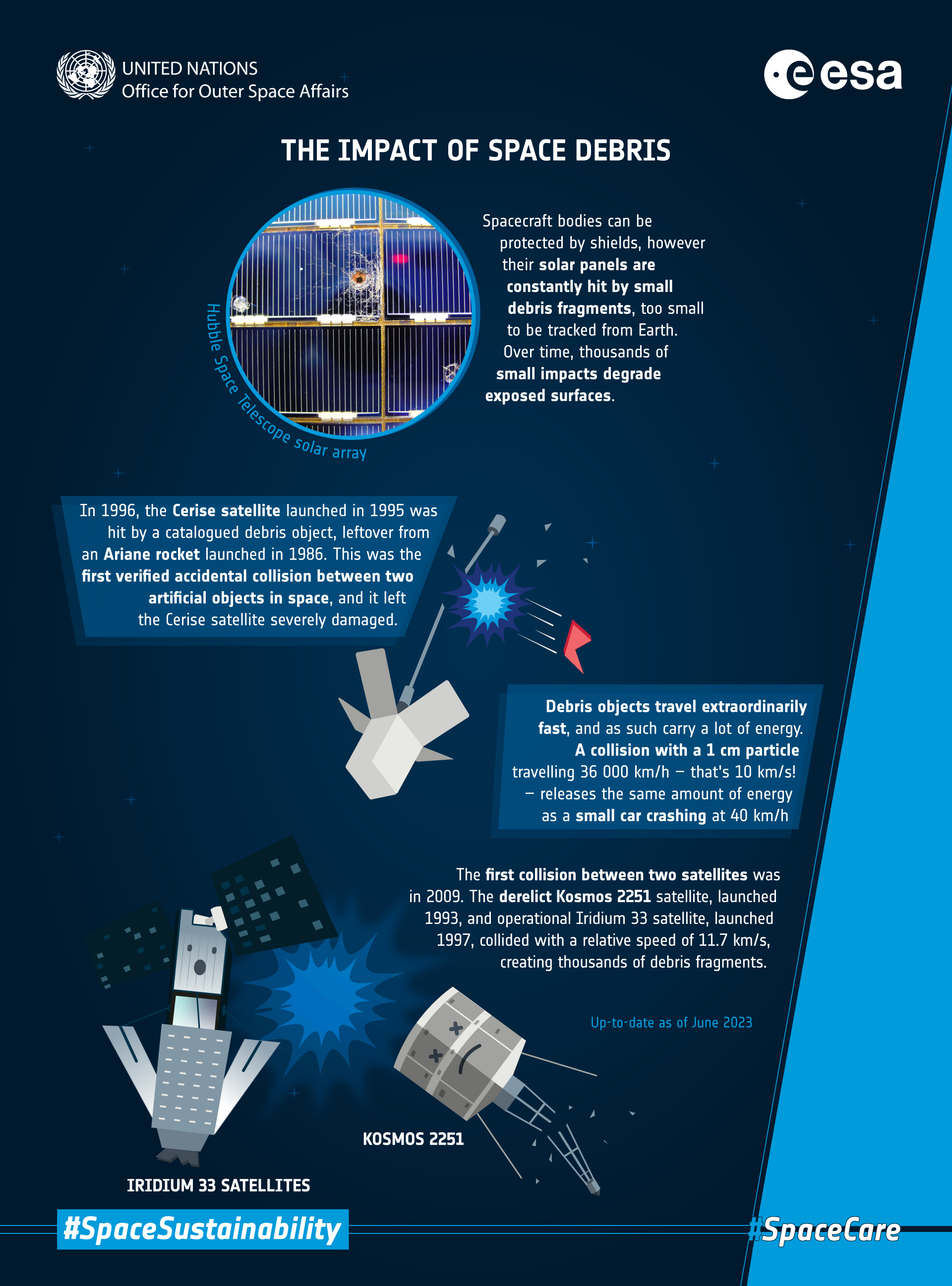
Debris in orbit varies from millions of millimetre-sized particles to thousands of much larger objects like defunct satellites and rocket parts. As such the damage debris can cause varies from a gradual degradation of satellite parts over time to its immediate and total destruction. The NASA/ESA Hubble Space Telescope has experienced decades of constant, minor bombardment from small debris objects, but collisions between entire satellites have also taken place, creating thousands of debris fragments. Debris objects travel at about 10 km/s, meaning a collision with just 1cm fragment can create the same amount of energy as a small car crashing at 40 km/h!
Find out more about the damage done by debris in the joint UNOOSA-ESA podcast that narrates this infographic below.
Listen to the podcast: https://soundcloud.com/esa/the-impact-of-space-debris
Infographic 8: space debris and human spaceflight
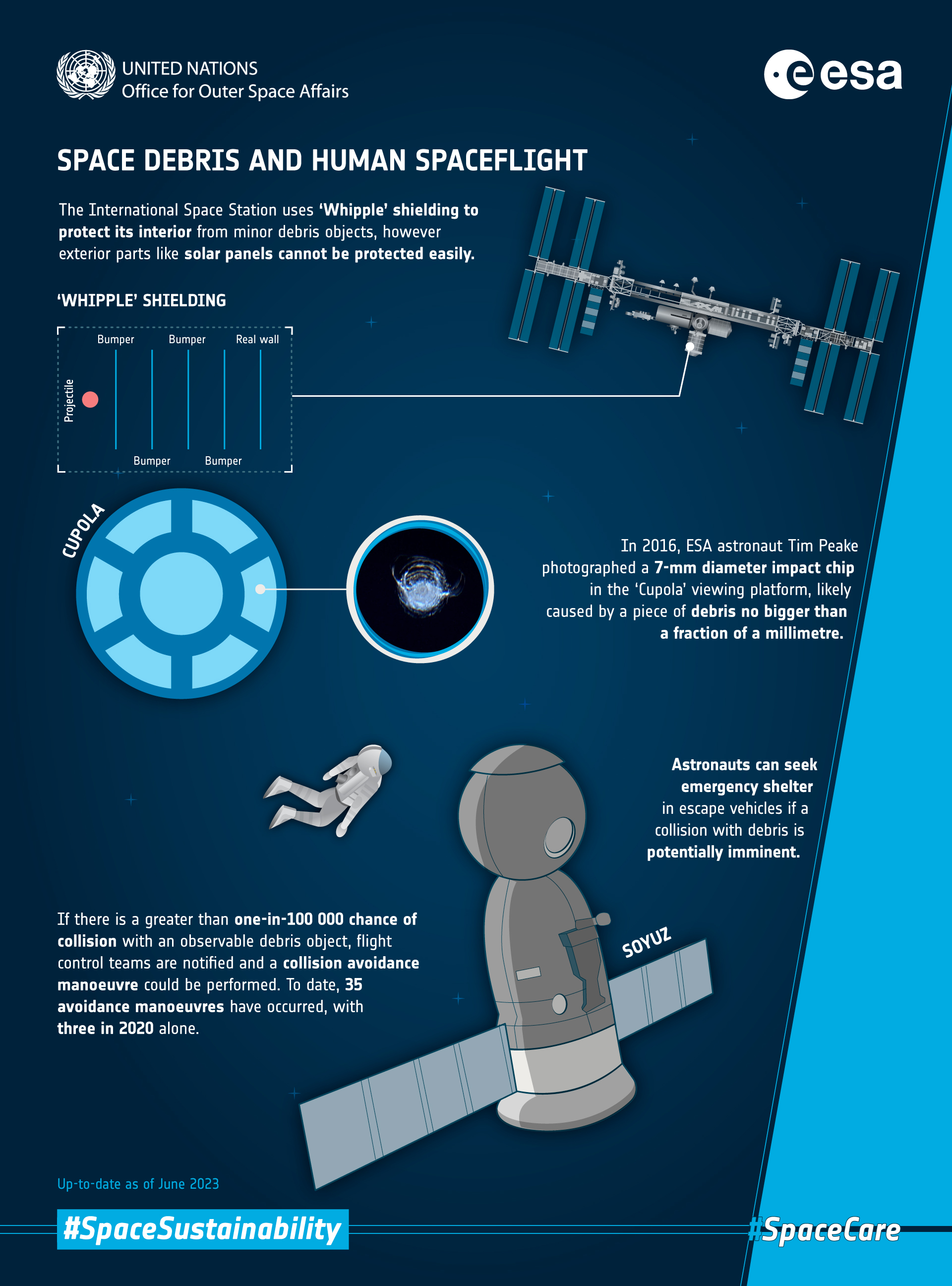
Humans in space have a lot to contend with, and for those in low-Earth orbit, space debris is a real concern.The International Space Station orbits Earth at an altitude of just over 400 km. In the two decades since its launch, 28 ' collision avoidance manoeuvres' have been performed in order to dodge space debris, with three taking place in 2020 alone. If a potential collision appears imminent, and there is no time to move the Station, they can take emergency shelter. To date, five 'shelter-in-place' manoeuvres have taken place, using the docked Soyuz spacecraft.
Find out more about the risk space debris poses to astronauts, including the "clanking" sounds they hear while in orbit, in the joint ESA-UNOOSA podcast that narrates this infographic.
Infographic 9: sustainable space
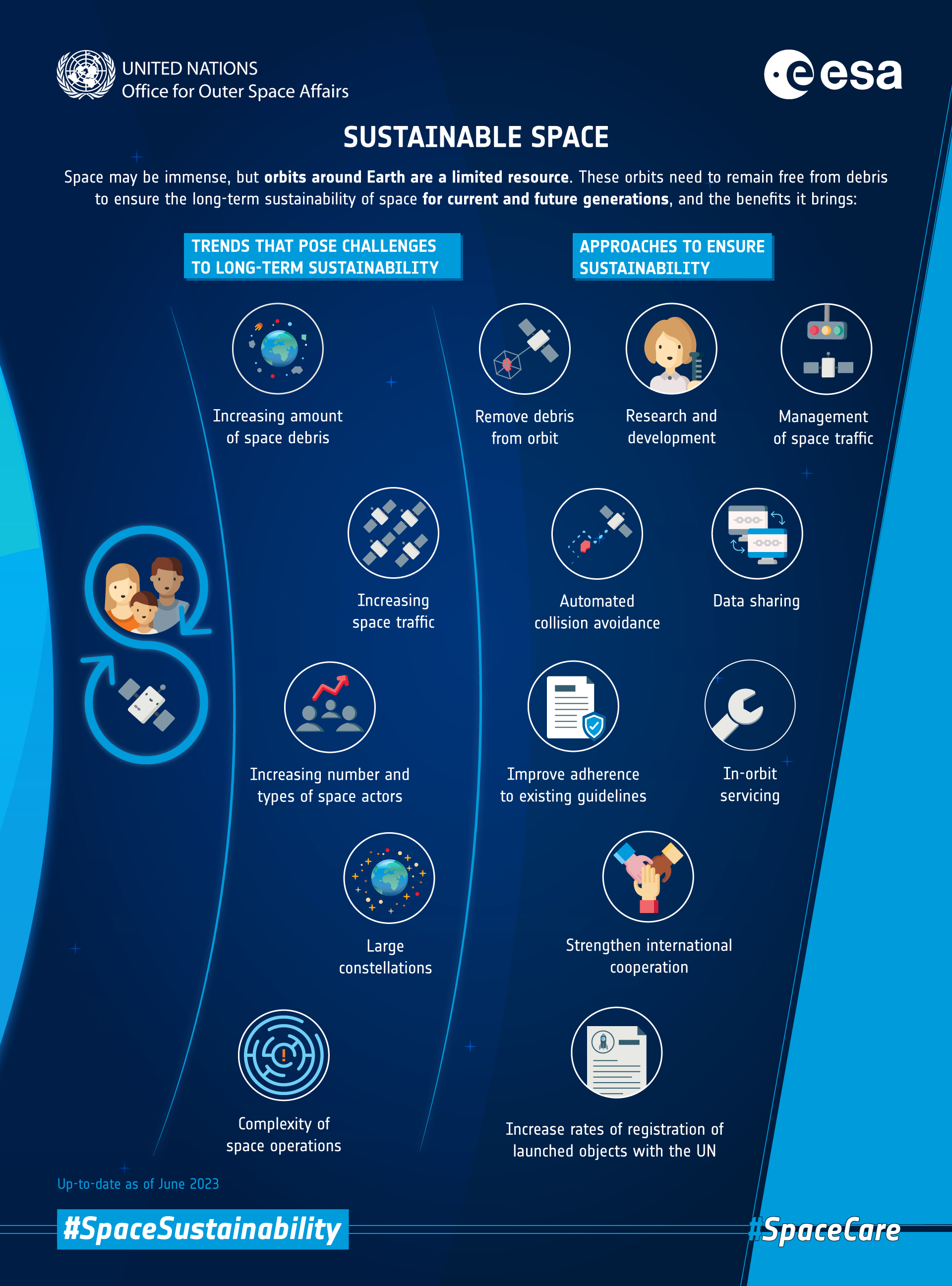
Space may seem vast, but the orbits around Earth in which satellites reside are a limited natural resource. However, since the beginning of the space age, millions of debris fragments have been created which now threaten any spacecraft that crosses their path. Satellite technology is now relied on around the world, and will become even more so. As such, it is becoming increasingly important to protect the unique orbital regions from where vital data is gathered for weather forecasting, climate research, communications and location services. There are many trends that threaten the long-term sustainability of space - increasing space traffic, more complex space operations and large constellations to name a few - but there are also approaches to secure our sustainable future. Find out more about how we can tackle space debris and secure near-Earth space for future generations in the joint UNOOSA-ESA podcast that narrates this infographic.
Listen to the podcast: https://soundcloud.com/esa/long-term-sustainability
A conversation between the former Director of UNOOSA Simonetta Di Pippo and ESA Director General Joseph Aschbacher, on the growing issue of space debris and how the international community can find collective solutions, complements the infographic series. Listen to it here!